Using Catalog Ads as a food & drinks brand
February 12, 2024

Food & Drinks is a huge industry, and the products you sell might differ greatly from those of others in the same industry. But, while your products might be different, there are a lot in common regarding advertising food & drinks.
Whether you sell pre-packaged foods, nutritional supplements, energy drinks, wine, or any other types of foodstuff, you can use the tactics in this overview!
We've looked through Catalog Ads from the best Food & Drinks advertisers in the world, and collected everything in this tactic overview.
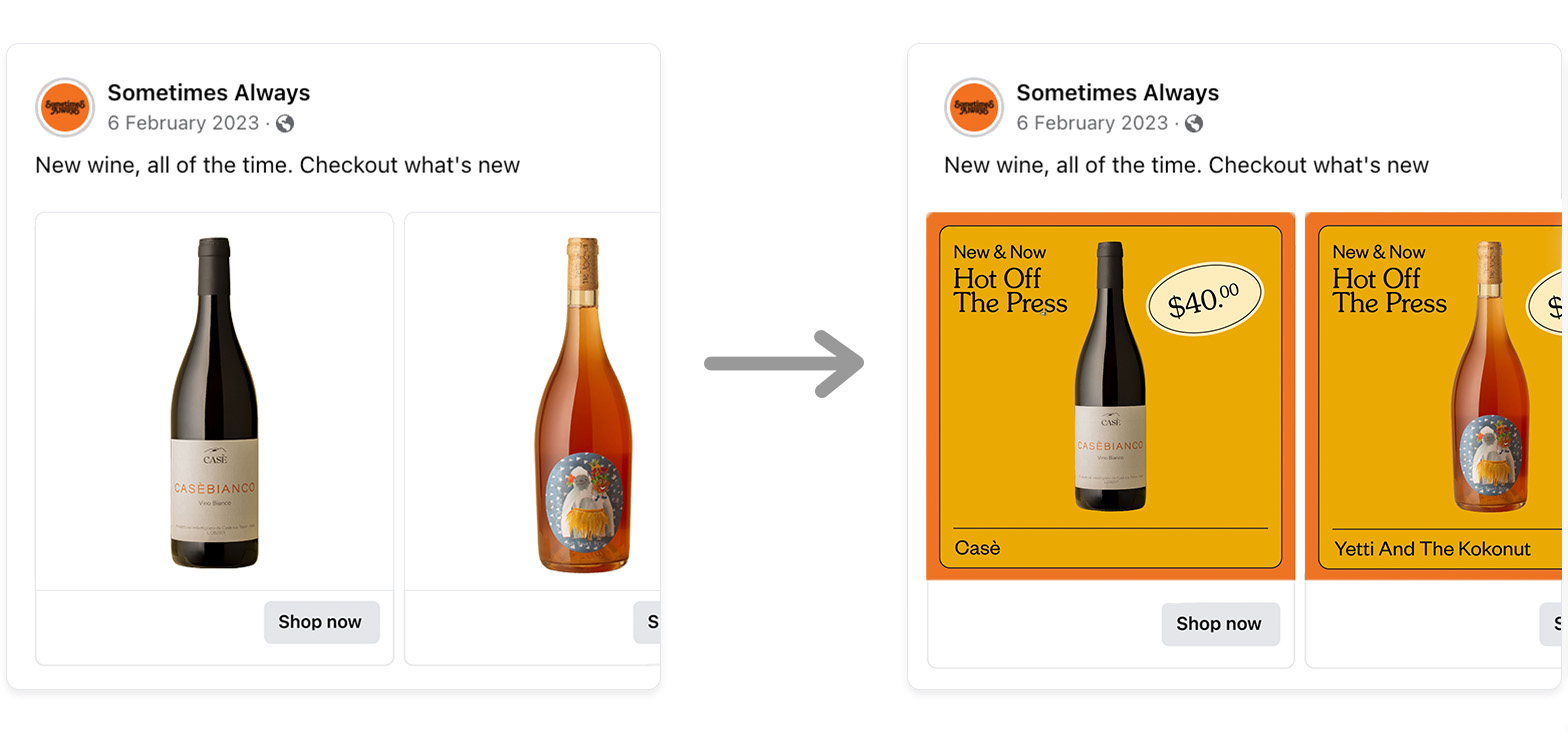
The Food & Drinks brands with the most success with their Catalog Ads generally have one thing in common.
They all make sure to test different tactics in these three areas: Always-on, Campaigns & Sales, and Product set specific ads.
Table of contents
Always-on Catalog Ads for Food and Drink Brands
Your "always-on" ads are an important and integral part of your sales funnel.
These are Catalog Ads that run all the time, which makes them the first touch point between a new potential customer and your business.
And remember: people buy food and drinks ALL THE TIME! I mean, who doesn't loooove a delicious pizza?
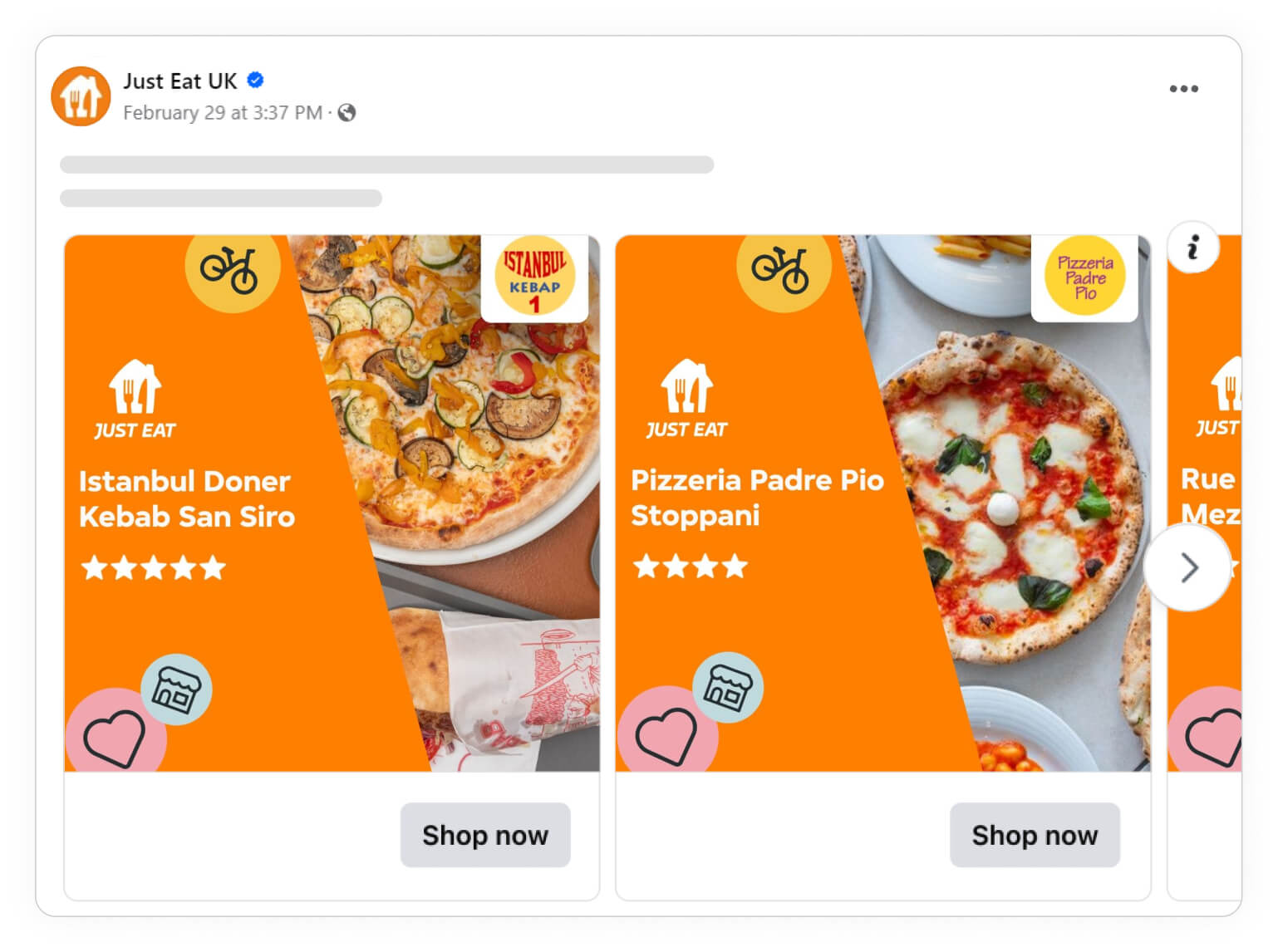
If an ad isn't different, eye-catching, or exciting, people are going to scroll right it!
So what's a food and beverage business to do?
Catalog Ads for building brand and increasing performance
Obviously, any ad format on Meta can be used to introduce your brand to the world and promote your products.
But Catalog Ads, they are typically the most effective when it comes to conversions.
.jpg)
Not only are Catalog Ads great for promoting more of your products in a single ad, they're also the best performing ad format used on Meta.
The real problem with these ads, however, is that marketers love them (because they perform and are automated), but designers hate them, because standard Catalog Ads just don't look all that nice.
The good news is that you can drastically improve your Catalog Ads by making design changes, like updating your ad backgrounds, adding logos, or by using all sorts of other product information.
The below Catalog Ad from Aldi is a great example of this. Showing the product with a serving suggestion (the dish), the product image, together with prices and savings.
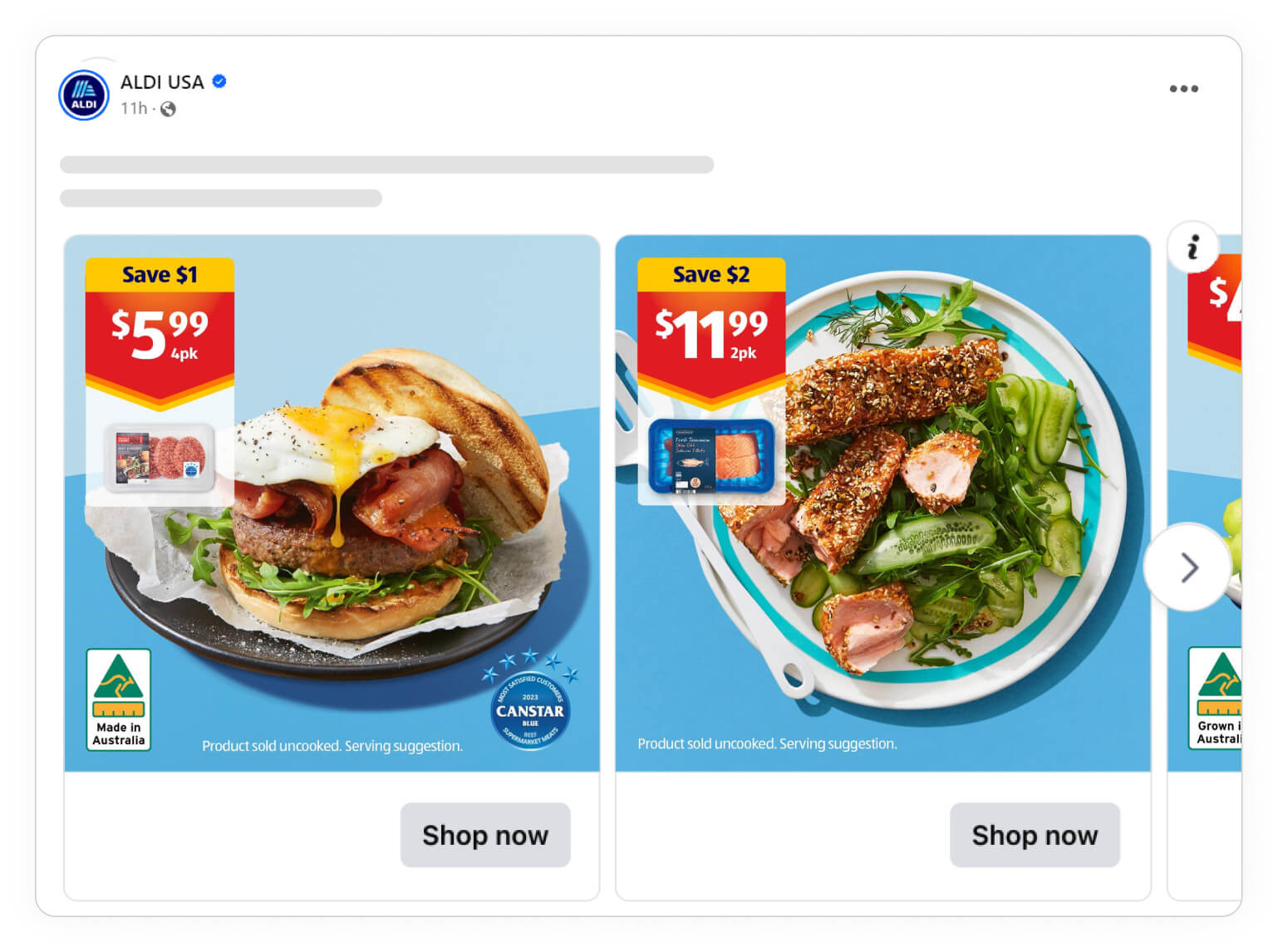
These are simple but effective strategies because they can help you screen your ad viewers, ensuring you get higher-quality traffic on your website.
So what are the best ways to design better Catalog Ads?
Showing your logo and brand colors
Things like your brand's logo or your colors ensure your viewers remember your brand next time they see those brand assets in their feed.
These visual assets are also a lot easier to notice than written text, which means they stand out to viewers while scrolling.
And that's exactly what we love about the following Catalog Ad example from Walmart Canada, where they show different products from different brands against their branded yellow background, their logo, and their tag-line about low prices. Each ad shows the product in its original packaging, which shows the product's logo and colors too.
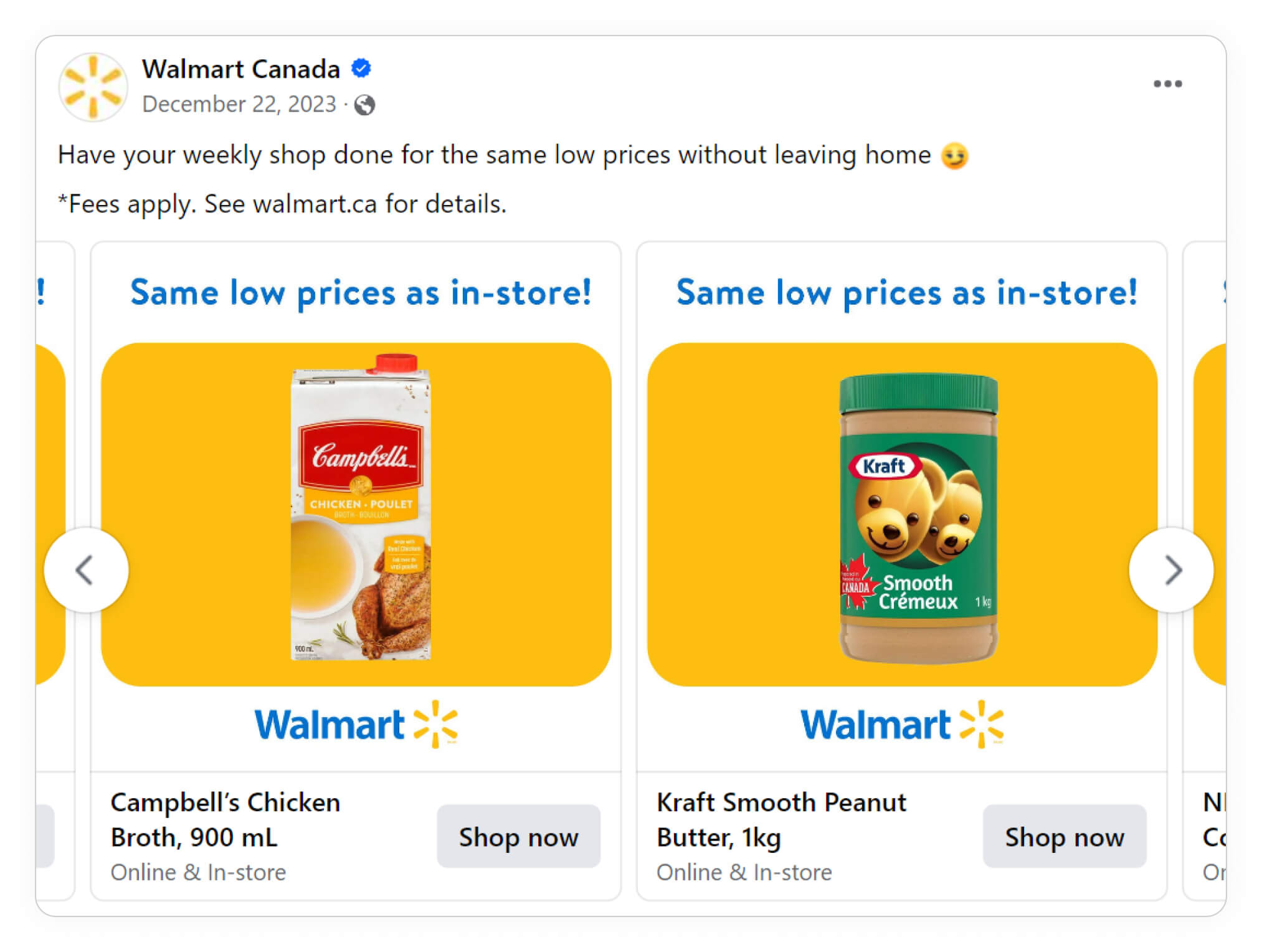
Another great strategy here is that they've included a slogan at the top of each ad. This can be a great place to add in your own branded slogan or a bit of extra information about the product.
Takeaway:
- Use existing brand assets (logos, colors, slogans) to create more memorable Catalog Ads.
- Brand assets help to build brand recognition for the future.
- Color theory can be applied to evoke feelings and emotions.
Nespresso is one of the well-established brands in the food & drinks industry (especially for coffee).
From their genius TV spots with George Clooney, to their classic muted glossy but still pastel colors they use everywhere - they have so many great brand elements!
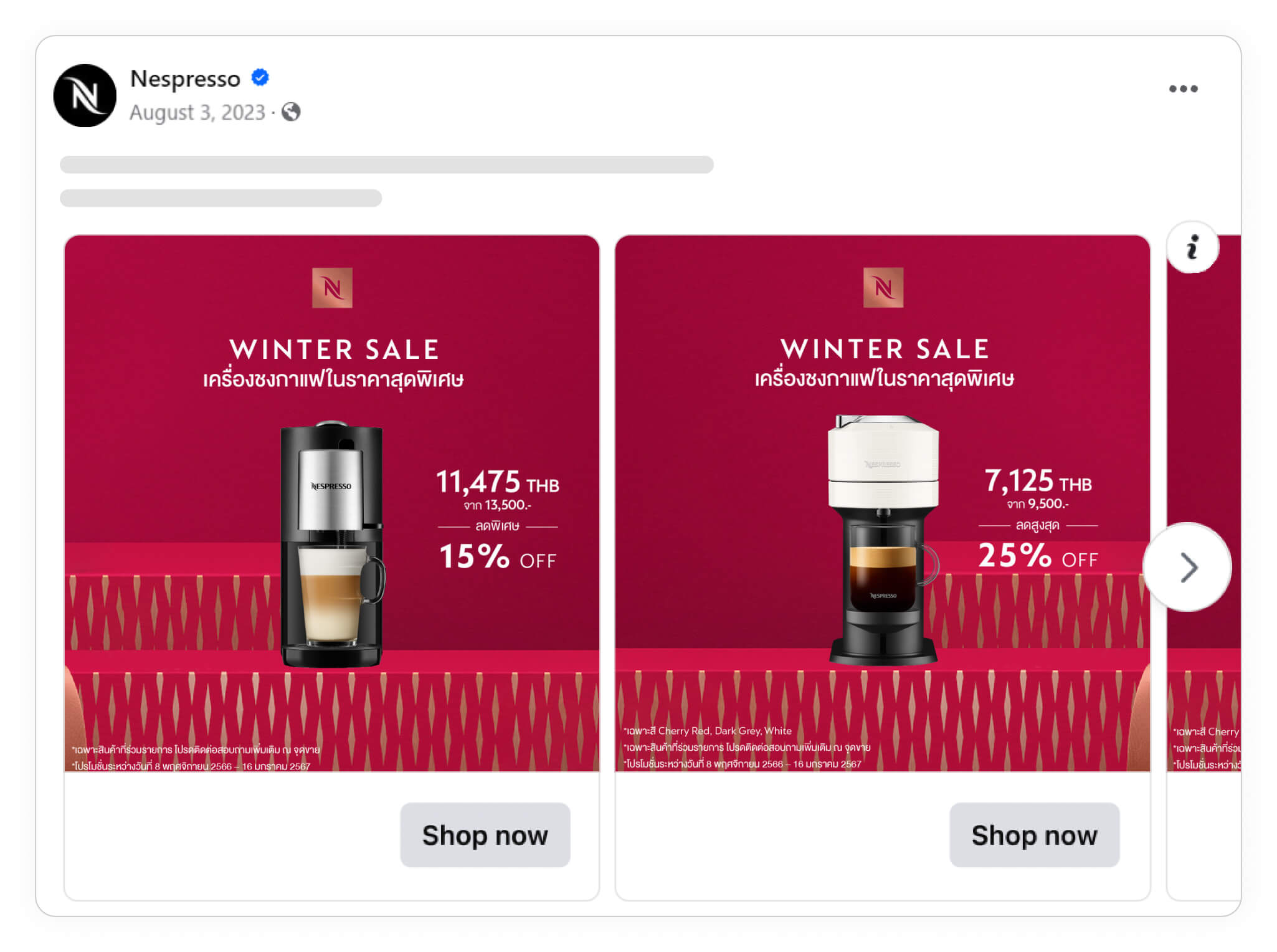
Their catalog ads are no exception - giving them a truly omnichannel brand.
In theory they could've excluded the logo from the design, and we would still be able to recognise that this was from Nespresso.
Product information and USPs
Food and drink brands can also use what makes their products unique to improve their Catalog Ads. Unique selling points (USPs) allow you to illustrate why somebody should think about buying your products.
The most simple USP is typically shop-specific. This can be free shipping like Wolt is advertising in this Catalog Ad:
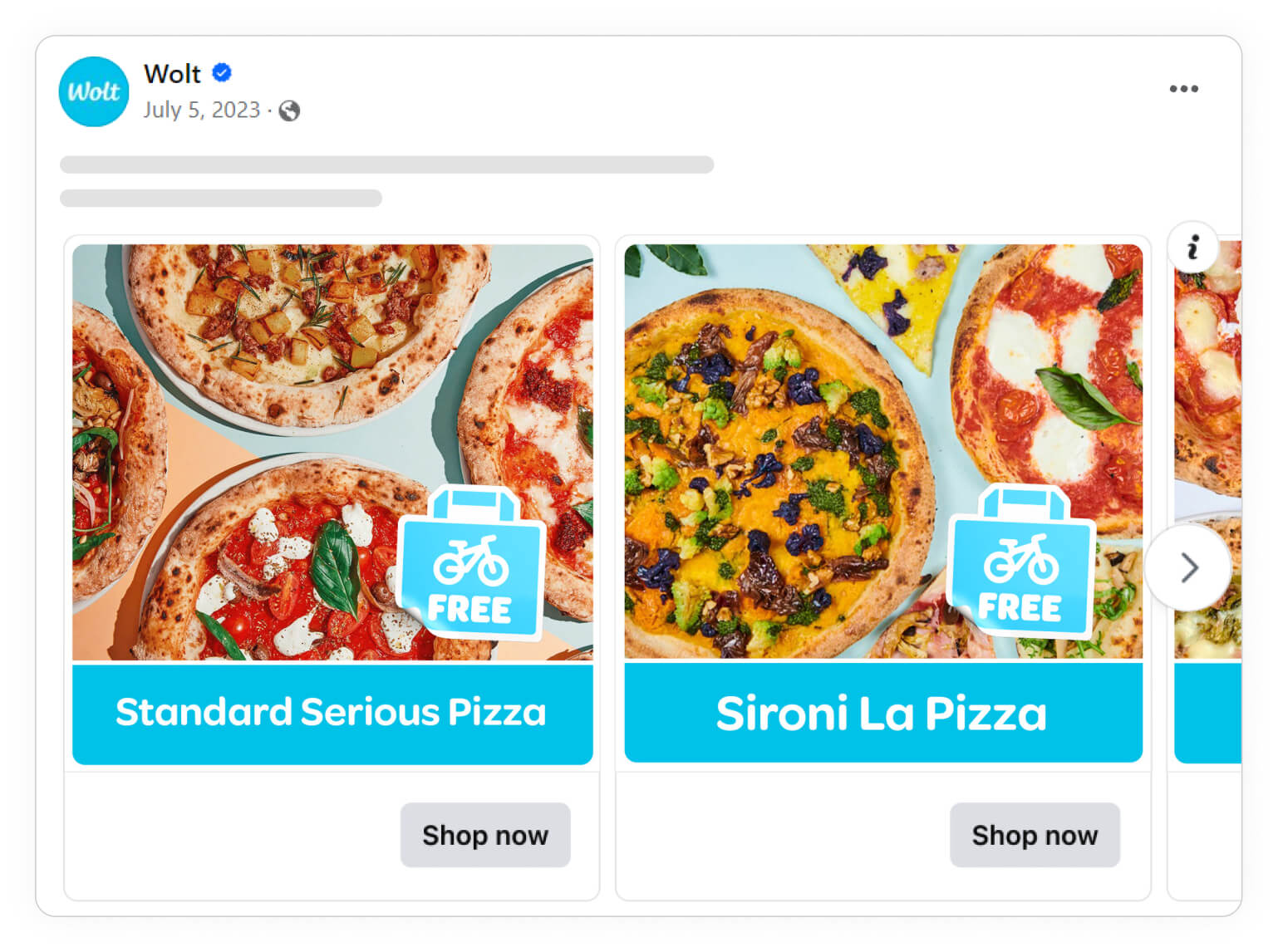
The following ad example from Chipp Coffee Co. highlights two USPs (sustainable and crafted with care) to show the audience whether or not this product is right for them.
Not everyone is going to recognize your brand. But by highlighting the fact that they make a sustainable and carefully-crafted product, these USPs build trust, which can improve the way people perceive your food or drink brand.

Just remember that Meta is phenomenal at targeting, which means their algorithm will do a decent job of showing your Catalog Ads to the right people. So when your content highlights important product information, USPs, or brand values, Meta will automatically show your ads to people with those same interests or values.
This can also be utilized by making specific designs for specific categories. In this example below, Nespresso have given their recycled products a specific design, together with USPs and info about their reloved products:
.jpg)
It's easy to assign specific design templates to specific product categories with Confect and its Design Rules.
Takeaway:
- Leverage product information you already have.
- Highlighting USPs can build trust when attracting new customers.
You can include whatever information you have about your products. In some cases, like the example below, it makes sense to include a lot of information.
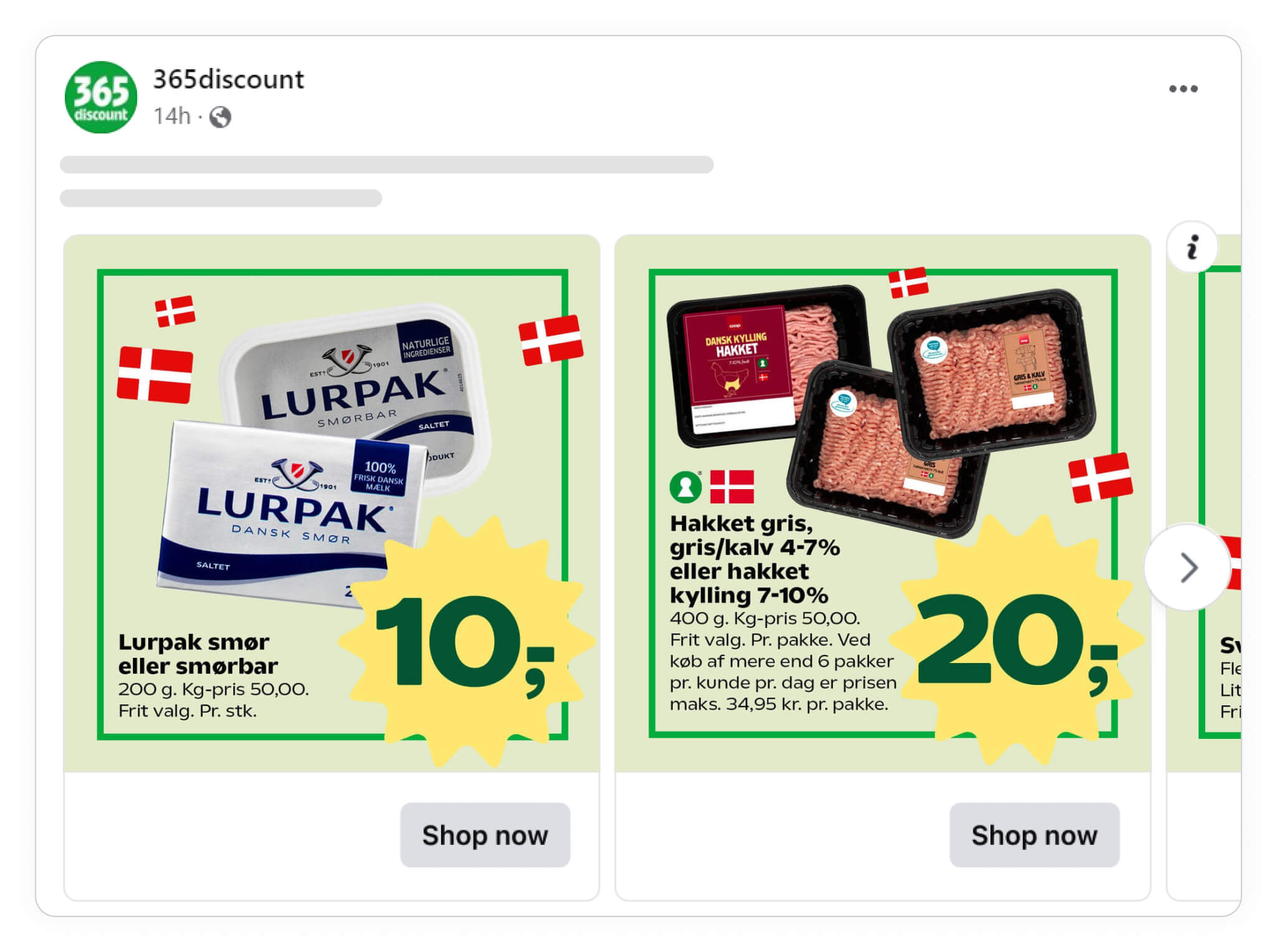
In this case, this supermarket has decided to show the name, the price, the weight, the price per kilogram, and, the description of the product. This is a lot!
The point is, that you can show whatever information you think or now that your customer is interested in knowing - or you are legally required to show, like price per kilo.
Building on perception
Selling food or drink products can also be about how people perceive it, how it makes them feel, or the emotions it evokes.
For example, the following Catalog Ad for Kaizer Luxury Oils, doesn't really talk much about the products themselves. Instead, the focus is placed on the quality of the product. The design of the creative is simple, but sleek and elegant. The colors evoke a sense of luxury and high-quality. And the rest of the information, logos, brand names, and product names are all second characters in the play.

Benefits:
- Perception can be a powerful tool for creating compelling Catalog Ads.
- You don't always need to focus on product information or USPs.
- Using colors and design theory are great ways to manifest different perceptions of your products.
Showing price and savings is a great tactic
S howing prices and savings information are also tried and true methods for getting people to notice your Catalog Ads.
Price is one of, if not THE most important decision-making factor people think about when shopping. So, by showing the price of your food or beverage products, your content will instantly align itself with the expectations of your target audience.
This is similar to the following ad example from Mathem, where they've used the price and savings details to entice people to think about buying the product.
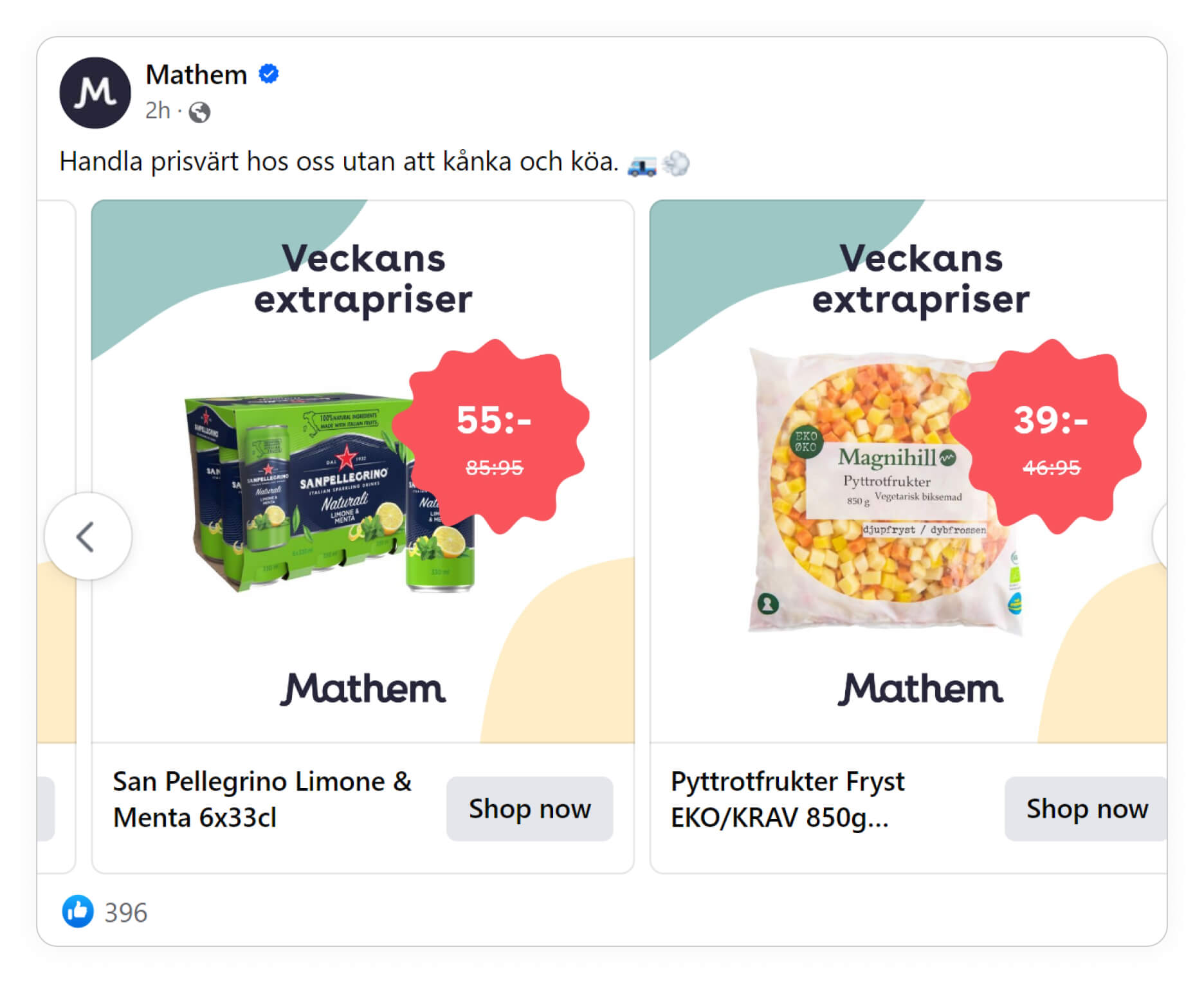
You can even use your brand's logo, colors, or fonts to create matching price tags or themes, making your content even more professional-looking and cohesive.
Takeaway:
- Price is an important decision-making factor for every potential customer.
- Pricing information can be used with brand assets to create cohesive, themed Catalog Ads.
- Pricing details are easy to implement into your existing ads and to have always-on.
Campaigns & Sales for food and drink brands
Like your always-on Catalog Ads, it's vital that campaigns are done right to ensure they have the best possible impact on your viewers.
One important factor to remember is that people love to see ads that match with the digital in-store experience. A true omnichannel experience - something brands like Nespresso is great at.
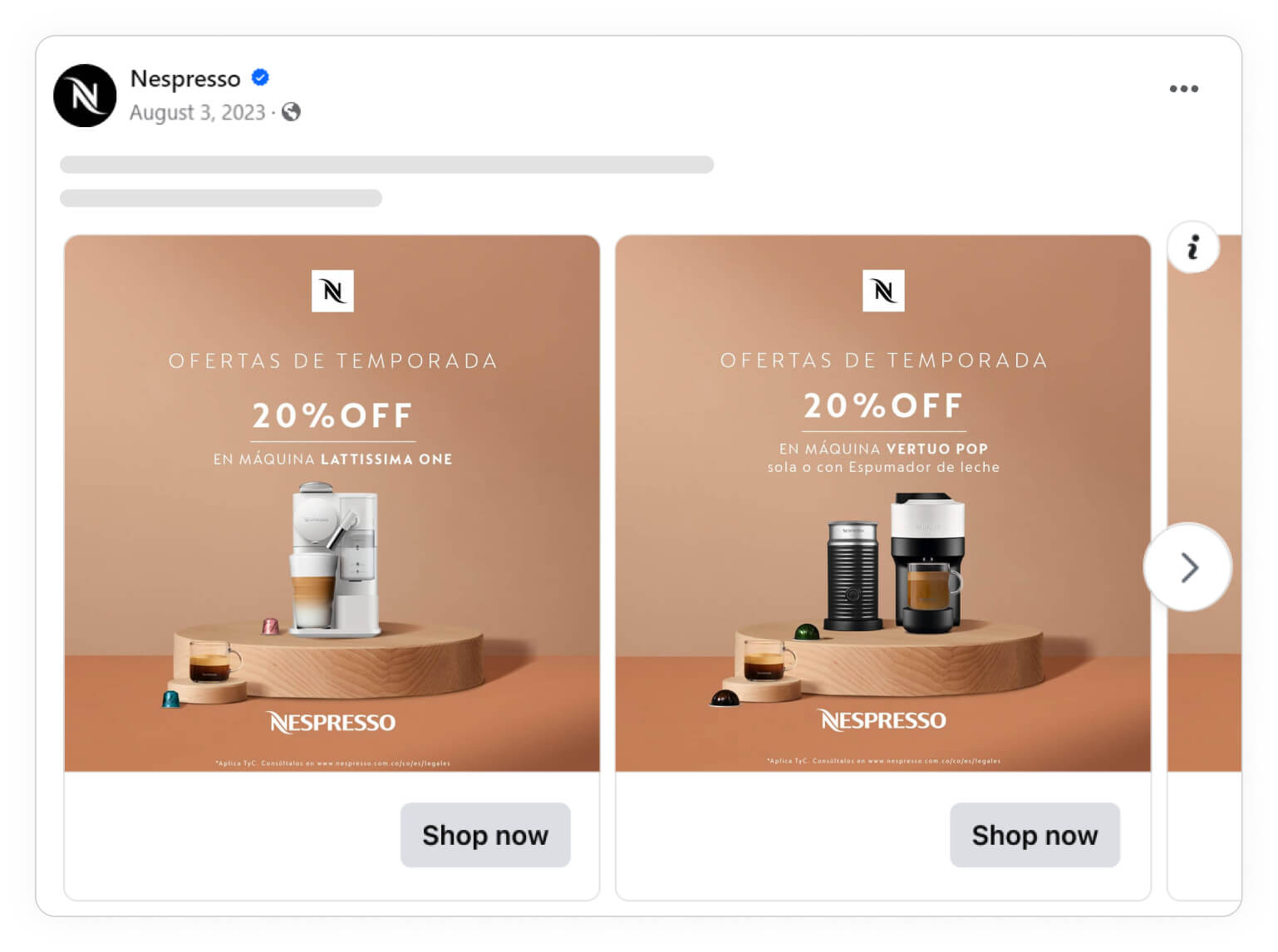
We strongly recommend matching the theme of your Catalog Ads with any existing brand assets, colors, and themes you have on your website.
Campaign periods
You can use virtually any existing calendar periods, like Black Friday, Christmas, Easter or Halloween, to create campaigns. But you can also create your own campaign periods for promoting daily, weekly, or monthly deals.
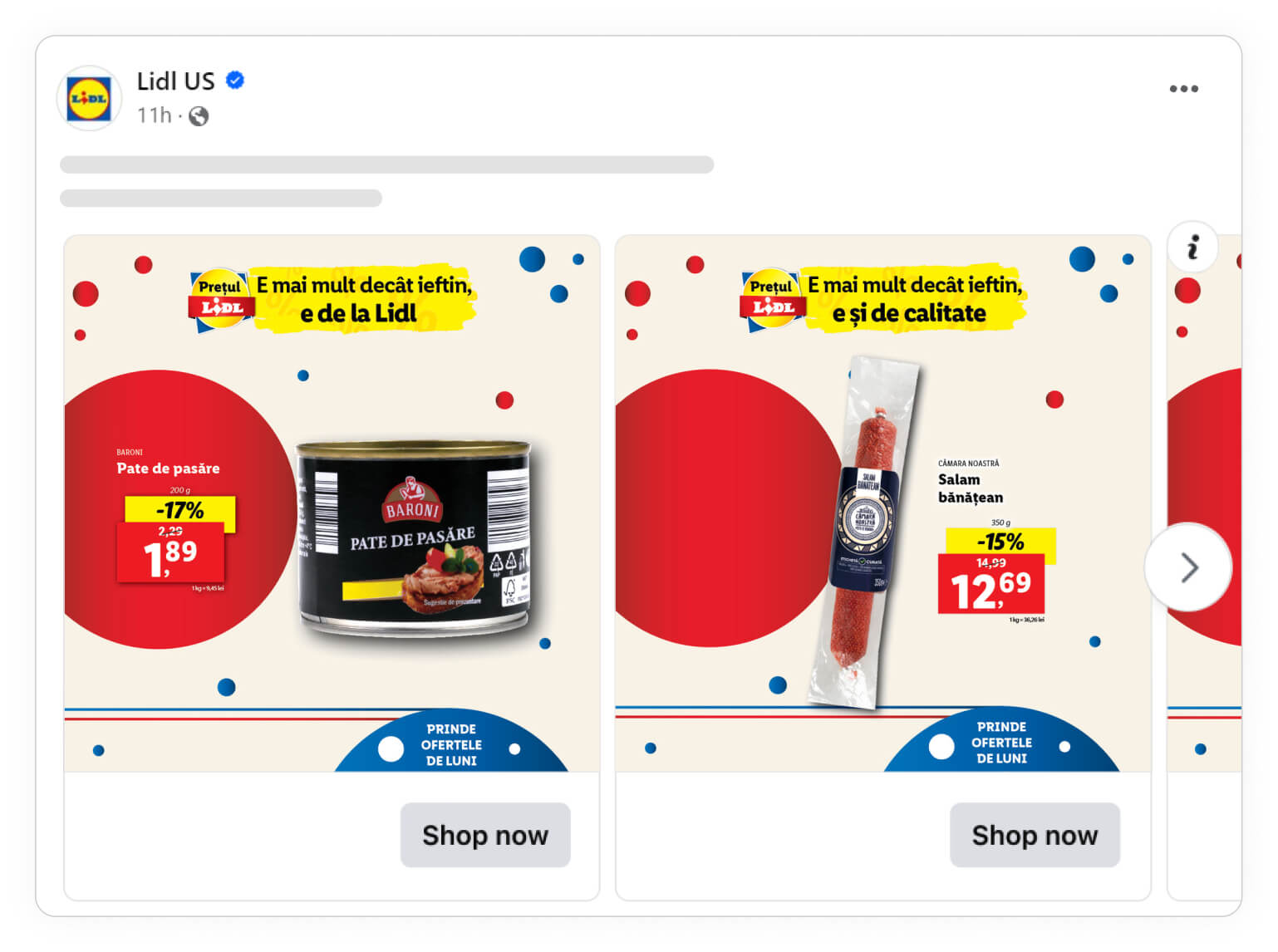
Campaign periods are ideal for creating Catalog Ads that are relevant to what's going on in the world at that time.
So, for instance, when December rolls around, you'd be a fool to run a Halloween campaign instead of updating your Catalog Ads to a Christmas-themed campaign.
Weekend sales
In the following ad example from Biedronka, the advertiser made use of a special weekend sale. This works to create a sense of urgency since viewers will feel like they only have the weekend before they miss out on the deal.
But more importantly, weekend sales are great because weekends are when most often people buy their food, groceries and take-out! We also love the way this ad gets a bit pushier by offering a "buy one, get one" deal.
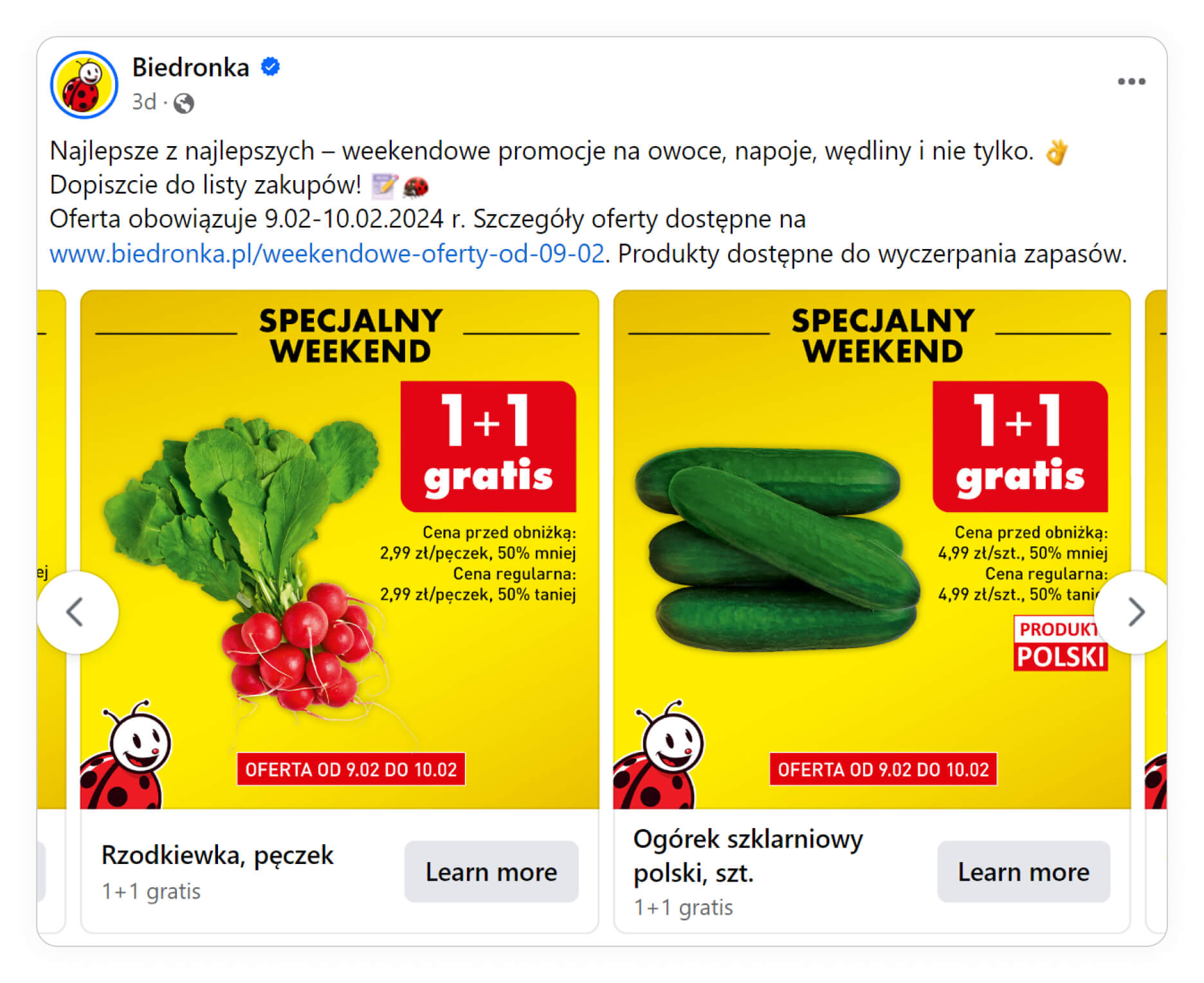
Takeaway:
- Weekend sales can create a sense of urgency
- People generally spend more money on food and drinks on weekends than they do throughout the week.
Time-limited campaigns
Limited-time campaigns are another great way to create a sense of urgency and drive viewers to act now. And that's exactly what ALDI Nord did when creating the following limited-time campaign.
By putting a close-time period on their sale, the ads push the viewer into wanting to act now before missing out. And the fear of missing is always a winning tactic!

We also love the way they've used pricing psychology, showing the regular price and the new discounted price, and the way they've created a bright, high-contrast image to grab viewer attention while scrolling.
Special coupons and loyalty club sales campaigns
Whether you use vouchers or special coupon codes, these types of campaigns are great because they make the viewer feel like they're getting something special and exclusive. It's another great way to make your customers feel like they're getting special and exclusive deals is by creating club member sales campaigns.
.jpg)
The Catalog Ad above is a great one from Burger King, showing their menus that have a special coupon this week. You need to be fast to get this great offer.
But especially supermarkets are utilizing this tactic.
Just like the following example from Lidl Slovensko, club member discounts are ideal for building a loyal customer base, and to keep them coming back time and time again. These types of campaigns are ideal for in-app sales or for email promotions.

Takeaway:
- Loyalty programs are great for creating loyal customers.
- It is ideal for in-app sales or email campaign use, but it can also be used to attract new loyal customers.
- Discount costs can be recouped by charging a new member fee.
Leveraging product information to sell more
Food and drink brands have so much product information (calorie count, protein, ingredients, etc.) available that it's a shame not to use it.
Product attributes and details can help screen your viewers, resulting in higher-quality traffic landing on your site pages.
Like the following ad from MyFitness, which includes the amount of protein in its supplement and the size of its packages, this brand obviously knows that protein content matters to its customers.

You can even use that product information to create specific types of campaigns based on product sets, types, or categories.
Showing product attributes is a great way to sell each product better and help consumers find the right product for them.
Product set driven sales
Running campaigns based on specific product categories or sets is another great way to amp up your Catalog Ads. These can be price-based categories, new arrivals, or popular product categories, or like in the following example, you can even base a product set campaign on a specific brand.
Here, the advertiser chose to create a sales campaign in which all products from a certain brand were available at a discounted price.
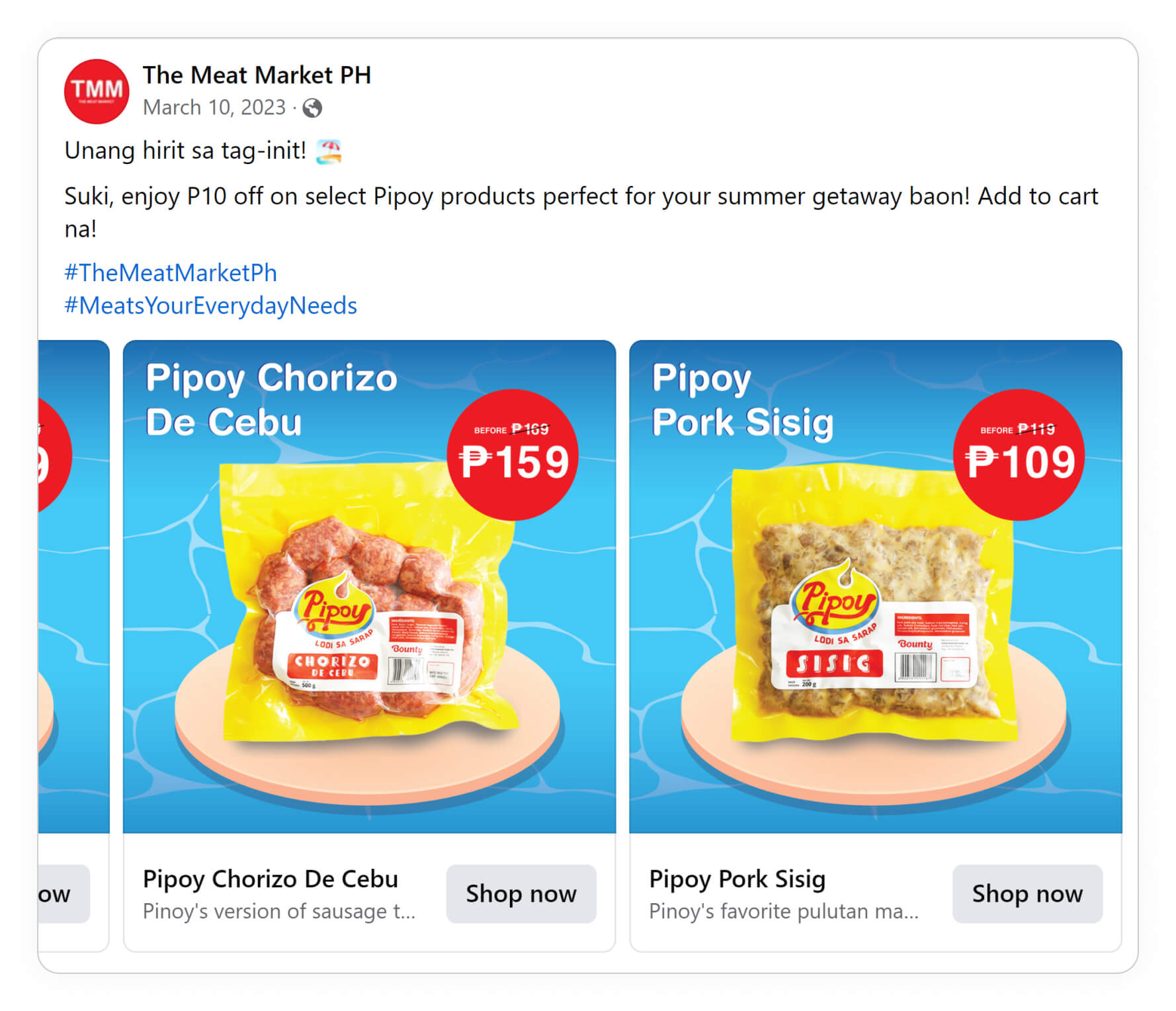
Takeaway:
- This tactic makes use of information you already have at your disposal.
- There's really no limit to what type of product sets you can come up with.
Creating Advantage+ Catalog Ads for food and drinks brands
As you can see, there really are all sorts of different strategies and tactics you can use to improve the quality of your Catalog Ads as a food and beverage brand.
And pretty much everything we've covered here is based on using the information you already have about your products and customers to make your Catalog Ads more relevant.
But just remember that these examples should only be used as inspiration, and there's no guarantee that using any one of them, or even all of them, will work for your brand.
So, as always, make sure to A/B test your ads, tweak and refine your strategy where needed, and focus only on doing more of what works, and less of what doesn't!
